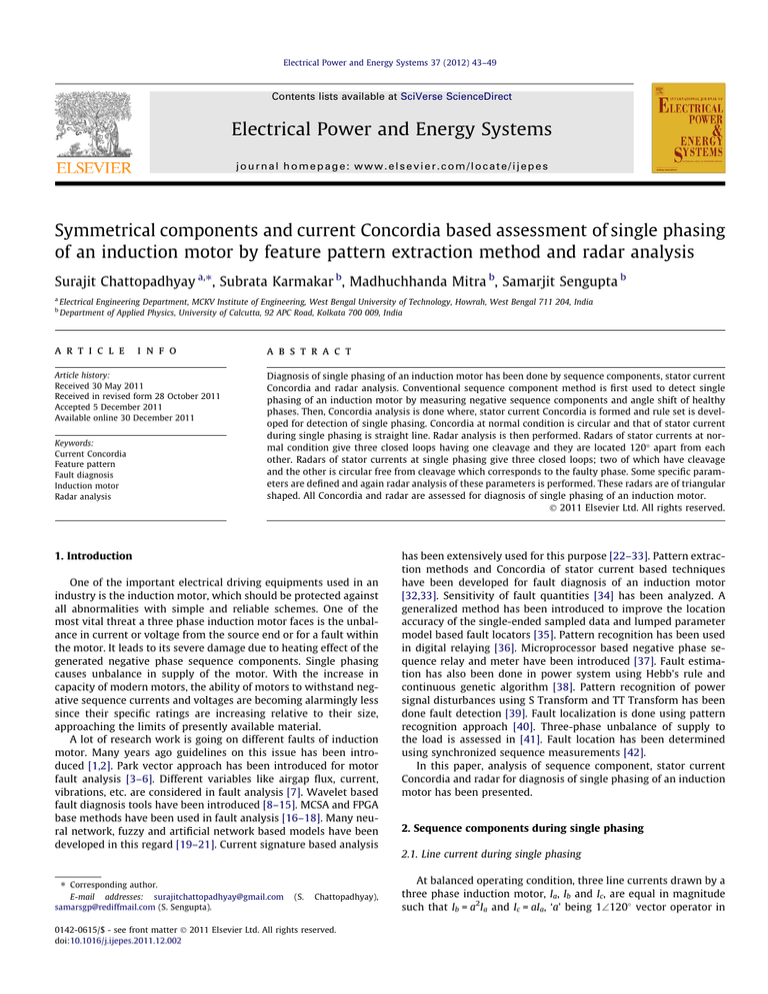
Electrical Power and Energy Systems 37 (2012) 43–49
Contents lists available at SciVerse ScienceDirect
Electrical Power and Energy Systems
journal homepage: www.elsevier.com/locate/ijepes
Symmetrical components and current Concordia based assessment of single phasing
of an induction motor by feature pattern extraction method and radar analysis
Surajit Chattopadhyay a,⇑, Subrata Karmakar b, Madhuchhanda Mitra b, Samarjit Sengupta b
a
b
Electrical Engineering Department, MCKV Institute of Engineering, West Bengal University of Technology, Howrah, West Bengal 711 204, India
Department of Applied Physics, University of Calcutta, 92 APC Road, Kolkata 700 009, India
a r t i c l e
i n f o
Article history:
Received 30 May 2011
Received in revised form 28 October 2011
Accepted 5 December 2011
Available online 30 December 2011
Keywords:
Current Concordia
Feature pattern
Fault diagnosis
Induction motor
Radar analysis
a b s t r a c t
Diagnosis of single phasing of an induction motor has been done by sequence components, stator current
Concordia and radar analysis. Conventional sequence component method is first used to detect single
phasing of an induction motor by measuring negative sequence components and angle shift of healthy
phases. Then, Concordia analysis is done where, stator current Concordia is formed and rule set is developed for detection of single phasing. Concordia at normal condition is circular and that of stator current
during single phasing is straight line. Radar analysis is then performed. Radars of stator currents at normal condition give three closed loops having one cleavage and they are located 120° apart from each
other. Radars of stator currents at single phasing give three closed loops; two of which have cleavage
and the other is circular free from cleavage which corresponds to the faulty phase. Some specific parameters are defined and again radar analysis of these parameters is performed. These radars are of triangular
shaped. All Concordia and radar are assessed for diagnosis of single phasing of an induction motor.
Ó 2011 Elsevier Ltd. All rights reserved.
1. Introduction
One of the important electrical driving equipments used in an
industry is the induction motor, which should be protected against
all abnormalities with simple and reliable schemes. One of the
most vital threat a three phase induction motor faces is the unbalance in current or voltage from the source end or for a fault within
the motor. It leads to its severe damage due to heating effect of the
generated negative phase sequence components. Single phasing
causes unbalance in supply of the motor. With the increase in
capacity of modern motors, the ability of motors to withstand negative sequence currents and voltages are becoming alarmingly less
since their specific ratings are increasing relative to their size,
approaching the limits of presently available material.
A lot of research work is going on different faults of induction
motor. Many years ago guidelines on this issue has been introduced [1,2]. Park vector approach has been introduced for motor
fault analysis [3–6]. Different variables like airgap flux, current,
vibrations, etc. are considered in fault analysis [7]. Wavelet based
fault diagnosis tools have been introduced [8–15]. MCSA and FPGA
base methods have been used in fault analysis [16–18]. Many neural network, fuzzy and artificial network based models have been
developed in this regard [19–21]. Current signature based analysis
⇑ Corresponding author.
E-mail addresses: surajitchattopadhyay@gmail.com
samarsgp@rediffmail.com (S. Sengupta).
(S.
Chattopadhyay),
0142-0615/$ - see front matter Ó 2011 Elsevier Ltd. All rights reserved.
doi:10.1016/j.ijepes.2011.12.002
has been extensively used for this purpose [22–33]. Pattern extraction methods and Concordia of stator current based techniques
have been developed for fault diagnosis of an induction motor
[32,33]. Sensitivity of fault quantities [34] has been analyzed. A
generalized method has been introduced to improve the location
accuracy of the single-ended sampled data and lumped parameter
model based fault locators [35]. Pattern recognition has been used
in digital relaying [36]. Microprocessor based negative phase sequence relay and meter have been introduced [37]. Fault estimation has also been done in power system using Hebb’s rule and
continuous genetic algorithm [38]. Pattern recognition of power
signal disturbances using S Transform and TT Transform has been
done fault detection [39]. Fault localization is done using pattern
recognition approach [40]. Three-phase unbalance of supply to
the load is assessed in [41]. Fault location has been determined
using synchronized sequence measurements [42].
In this paper, analysis of sequence component, stator current
Concordia and radar for diagnosis of single phasing of an induction
motor has been presented.
2. Sequence components during single phasing
2.1. Line current during single phasing
At balanced operating condition, three line currents drawn by a
three phase induction motor, Ia, Ib and Ic, are equal in magnitude
such that Ib = a2Ia and Ic = aIa, ‘a’ being 1\120 vector operator in
44
S. Chattopadhyay et al. / Electrical Power and Energy Systems 37 (2012) 43–49
the anticlockwise direction where the zero and negative sequence
components are absent.
At unbalance, negative and zero sequence components appear
an equal in magnitude and the resultant motor stator currents
can be written as follows:
Ia ¼ Ia0 þ Ia1 þ Ia2
ð1Þ
Ib ¼ Ib0 þ Ib1 þ Ib2 ¼ Ia0 þ a2 Ia1 þ aIa2
ð2Þ
Ic ¼ Ia0 þ aIa1 þ a2 Ia2
ð3Þ
where the subscripts 0, 1 and 2 represent zero sequence, positive
sequence and negative sequence components only. Zero sequence
components are absent so that Ia0 = 0, in case of induction motor
under unbalanced condition.
Single phasing is an example of extreme situation of unbalance.
Let us consider, it has occurred at phase c, i.e., Ic = 0. Then, from (3)
Ia1 ¼ aIa2
ð4Þ
Ia ¼ ð1 aÞIa2
ð5Þ
Ib ¼ ð1 aÞIa2
ð6Þ
From, (5) and (6),
Ib ¼ Ia
ð7Þ
From (4),
Ia2 ¼ a2 Ia1 ¼ Ia1 \60
ð8Þ
Therefore,
Ia2 ¼ Ia1 \60
ð9Þ
Similarly,
Ib1 ¼ Ib2 \60
ð10Þ
Ic1 ¼ Ic2 \180
ð11Þ
Under phase-c absent condition, (9)–(11) reveal that the negative sequence components in ‘a’ and ‘b’ phases (healthy phases)
are displaced by 60° from the respective positive sequence components and that of phase-c (faulty phase) is 180° out of phase from
its positive sequence component. The negative sequence components are generated at this phase orientation with the start of
unbalance in phase-c. Similarly, when unbalance occurs in phases
‘a’ and ‘b’, the same phenomena occur relative to those phases. So
the relative phase orientations of the negative sequence components with respect to positive sequence components depend on
which phase the unbalance has occurred. Fig. 1a–c show the relative orientations of the negative phase sequence components with
respect to the positive phase sequence components when unbalance occurs in phase-c, a and b respectively considering a–b–c as
the phase sequence of the positive sequence components and a–
c–b as that of the negative sequence components.
2.2. Detection of magnitude of negative sequence currents
Let ia, ib and ic be the instantaneous line currents drawn by an
induction motor and Ia2, Ib2 and Ic2 be the instantaneous negative
sequence current components at any particular instant of current
unbalance caused at phase-c. At any moment the instantaneous
line current is obtained as the vector sum of the corresponding positive and negative sequence components. Fig. 1a thus shows that,
with the start of unbalance in phase-c, ia2 and ib2 start generating
60° apart from Ia1 and Ib1 whereas ic2 generates 180° out of phase
from Ic1, and the instantaneous line currents ia and ib are the vector
sum of the corresponding positive and negative sequence compo-
Fig. 1. Phasor diagram of negative sequence currents and space orientation
between positive and negative sequence currents for unbalance in (a) phase-c, (b)
phase-a and (c) phase-b. Left hand side figures indicate start of unbalance and right
hand side figures, single phasing conditions.
nents. Thus with the increase of ia2, magnitude of ia increases
and the ia vector displaces from Ia1 in the counter clock wise direction. As seen in Fig. 1b, at Ic = 0, magnitude of ia is maximum and is
displaced by 30° from Ia1. Similar is the case for phases-a and b
also.
Thus the angular displacement between current vectors of
phases-a and b changes from 120° to 180° as the magnitude of
ia2 increases. This change is gradual. It is thus evident that the
angular shift between the healthy phase current vectors in excess
of 120° is a measure of the degree of unbalance in the system.
In Fig. 1a, if ha be the angle between Ia1 and ia at any instant of
unbalance, then ha can be represented as
pffiffiffi
3v
tan ha ¼
2þv
ð12Þ
where ha = 30° and v = (Ia2/Ia1) is the p.u. negative sequence current
with respect to its positive sequence current.
Then, (12) yields,
2 tan ha
2 tan ha
v ¼ pffiffiffi
3 tan ha
ð13Þ
(13) gives an almost linear relation between ha and v.
Similar phenomena happen for unbalances due to single phasing in phases a and b.
ID
399945
Title
SymmetricalcomponentsandcurrentConcordiabasedassessmentofsinglephasingofaninductionmotor
byfeaturepatternextractionmethodandradaranalysis
http://fulltext.study/article/399945
http://FullText.Study
Pages
7


